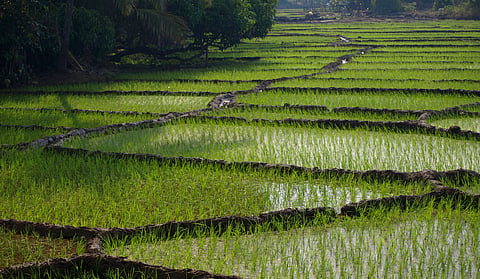Rice farming in India is deeply intertwined with spatial climate effects
I and my colleagues recently published an analysis of rice farming in India, in Economic Analysis and Policy. It presents compelling evidence of significant spatial climate effects on crop yield, underscoring the necessity of incorporating regional dimensions into agricultural productivity assessments. Using disaggregated panel data from three decades, combined with demographic and weather variables, the study highlights how Indian rice farming is particularly sensitive to spatial spillovers, with both direct and indirect effects shaping production outcomes.
One of the central findings is the presence of strong spatial autocorrelation in rice production. High-yield districts, particularly in northern and southern India, were found to be spatially clustered, with adjacent districts also reporting high yields. This is reflected in positive global Moran statistics for rice yield across all years of analysis (1995, 2005, and 2015). Conversely, low-yield districts, primarily in the central and western regions, exhibited similar spatial clustering of low production. The Local Indicator of Spatial Association (LISA) test further identified the presence of high-high and low-low clusters, indicating significant local spatial correlations that shape regional agricultural performance.
In terms of climate impacts, the results offer a granular understanding of how weather variability influences rice yields. For instance, a one per cent increase in maximum temperature during the autumn season was associated with a 1.011 per cent reduction in yield in the affected district and a 0.996 per cent reduction in neighbouring districts. Similarly, a one per cent increase in rainfall during the rainy season resulted in a 0.169 per cent increase in rice yield within the district and a 0.161 per cent rise in neighbouring areas. These figures underscore the sensitivity of rice production to weather fluctuations, with neighbouring districts not only affected by their own climatic conditions but also by those of adjacent regions.
Moreover, non-climate factors such as population density, labour availability, and fertiliser usage also exhibited spatial effects. A one per cent increase in fertiliser application resulted in a 0.035 per cent increase in yield in the district and 0.034 per cent in neighbouring districts, highlighting the role of input spillovers. Similarly, a one per cent rise in population density increased yields by 0.084 per cent in the district and by 0.622 per cent in neighbouring regions, emphasising how social and economic interactions between farmers enhance agricultural productivity.
The vulnerability of Indian rice farming to exogenous and endogenous shocks, particularly in low-yield regions, remains a central concern. India’s heavy reliance on rainfed agriculture—52 per cent of rice planting areas are rainfed—makes it particularly susceptible to climate volatility. Historical data reinforce this risk; for example, rice output fell by 10.1 per cent during the 2009 drought but increased by 16.8 per cent in 2011-12 due to improved weather conditions. Such variability raises questions about the sustainability of rice production in the face of climate change, particularly for regions with low adaptive capacity.
The study introduces a novel approach by employing spatial econometric models to account for spatial heterogeneity and dependence, factors often overlooked in traditional climate-agriculture models. The concept of “neighbourhood effects” is particularly relevant in this context, as climatic and social factors in one district were shown to affect agricultural outcomes in neighbouring areas. For example, the correlation between rainfall and evapotranspiration in a district and its neighbours significantly influences rice yields, with both direct and indirect effects shaping overall productivity.
Additionally, the inclusion of indirect spillovers from non-climate factors provides deeper insights into production dynamics. While irrigation expansion within a district led to a 0.111 per cent increase in yield, there were no significant spillover effects observed in neighbouring areas. Conversely, population density and rainfall demonstrated strong spatial interdependencies, where increases in these factors in one district positively affected yields in adjacent regions.
Lessons for India
From a policy perspective, these results underline the critical need for spatially targeted interventions to enhance agricultural resilience. For instance, improving irrigation infrastructure and adopting climate-smart rice varieties in low-yield areas could significantly mitigate the adverse impacts of climate change. Furthermore, the development of tailored agricultural extension services that account for the spatial dynamics of farming communities could help facilitate the diffusion of knowledge and best practices across regions. Such services are particularly important for disseminating information on climate adaptation strategies and ensuring that smallholder farmers are equipped to deal with increasing climate variability.
The study also suggests that spatial spillovers could play a vital role in improving productivity through collaborative farming practices and the sharing of resources. As population density rises and farming communities become more interconnected, opportunities for peer learning and technology diffusion increase, potentially mitigating some of the adverse effects of climate shocks.
In conclusion, this analysis provides robust empirical evidence that rice farming in India is deeply intertwined with spatial climate effects, which must be accounted for in future agricultural policy frameworks. The findings highlight the importance of spatial econometric approaches in evaluating the full impact of climate change on agriculture, offering policymakers a more nuanced understanding of regional vulnerabilities and opportunities for targeted interventions. Given the increasing volatility of weather patterns and their disproportionate effects on agricultural regions, formulating policies that address both local and regional climate impacts is essential for sustaining rice production in India. The results also emphasise the broader implications of spatial spillovers in shaping agricultural outcomes, underscoring the need for coordinated efforts to enhance productivity across neighbouring districts.
The writer is with NCAER, New Delhi
Views expressed are the author’s own and don’t necessarily reflect those of Down To Earth


